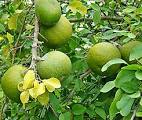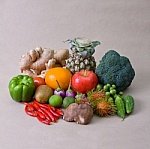Health benefits of eating Bael fruit grown throughout India as well as in Sri Lanka, Bangladesh, Pakistan, Burma, Thailand and in most of the south-east Asian countries
Health benefits of eating Bael fruit !
Description of bael fruit
The bael occupies an important place among the indigenous fruits of India. It is a woody and smooth food which is 5 to 15 cm in diameter.
It has numerous seeds, which are densely covered with fibrous hairs and are embedded in a thick aromatic pulp. The flesh is either eaten fresh or dried.
Origin and Distribution
The bael tree is indigenous to India. The history of this tree bas been traced to Vedic period – 2000 BC-800 BC.
The bael fruit is grown throughout India as well as in Sri Lanka, Bangladesh, Pakistan, Burma, Thailand and most of the south-east Asian countries.
Food value
An analysis of the bael fruit shows it is rich in mineral and vitamin contents. The sherbet made out of this fruit has all the important nutrients and health growing ingredients.
It should be thick and syrupy enough to be taken with spoon and it should be thoroughly masticated. If taken hurriedly, it may produce heaviness in the stomach.
The bael fruit should also not be taken in excess at a time as excessive intake of bael may produce a sensation of heaviness in the stomach and may cause gastric discomfort.
Natural health benefits of eating bael fruit and its curative properties
The bael is one of the most useful medicinal plant, in India. All the parts of this tree including stem, bark, root, leaves and fruit at all stages of maturity has medicinal virtues and has been used as traditional medicine for a long time.
The fruit is of considerable medicinal value when it just begins to ripen. The ripe fruit is aromatic, astringent which helps construction of skin, coolant and laxative.
The unripe or half-ripe fruit is astringent, digestive stomachic which improves appetite and antiscorbutic, i.e. which helps to fight scurvy caused due to vitamin C deficiency.
Constipation
Ripe bael fruit is regarded as best of all laxatives. It cleans and tones up the intestines. Its regular use for two or three months helps evacuate even the old accumulated faecal matter from the bowels.
For best results, it should be taken in the front of sherbet, which is prepared from the pulp of the ripe fruit. After breaking the shell, the seeds are first removed, and contents are then taken out with a spoon and passed through a sieve.
Milk and little sugar may be added to make it more palatable. The pulp of the ripe fruit can also be taken from the spoon without the addition of milk or sugar. About 60 gms, of the fruit will suffice for an adult.
Diarrhoea and Dysentery
The unripe of half ripe fruit is perhaps, the most effective food remedy for chronic diarrhoea and dysentery where there is no fever. Best results are obtained by the use of dried bael or its powder.
The bael fruit, when it is still green, is sliced and dried in the sun. The dried bael slices are reduced into powder and preserve in air-tight bottles. The unripe bael can also be baked and taken with jaggery or brown sugar.
The fruit appears to have little effect in acute dysentery when there is definite sensation to defaecate but instead of significant amounts of faeces, blood and mucus alone are passed.
The powdered drug is specially recommended in this condition. Its beneficial effect is, however, most evident when the condition has become sub-acute or chronic.
After the use of the fruit in these conditions, the blood gradually disappears and the stool assume a more feculent and solid form. The mucus also disappears after continued use for some time.
It is also a valuable remedy for chronic dysenteric conditions characterised by alternate diarrhoea and constipation.
Peptic Ulcer
An infusion or bael leaves is regarded as an effective food remedy for peptic ulcer. The leaves are soaked overnight in water. This water is strained and taken as a drink in the morning.
The pain and discomfort are relieved when this treatment is continued for a few weeks. Bael leaves are rich in tannins which reduce inflammation and help healing of ulcers.
The bael fruit taken in the form of beverage has also great healing properties on account of its mucilage, i.e. sticky or viscous content. This substance forms a coating on the stomach mucosa and thus helps in the healing of ulcers.
Respiratory Affections
A medicated oil prepared from bael leaves gives relief from recurrent colds and respiratory affections.
The juice extracted from bael leaves is mixed with equal quantity of sesame oil and heated thoroughly. A few seeds of black pepper and half a teaspoonful of black cumin are added to the hot oil.
It is then removed from the fire and stored for use when necessary. A teaspoonful of this oil should be massaged into the scalp before a head bath. Its regular use builds up resistance against colds and coughs.
A common practice in south India is to give the juice of bael leaves to bring relief from wheezing and respiratory spasm. The leaf juice, mixed in warm water with a little pepper, is given as a drink.
RELATED TOPICS
Food manufacturing companies in Singapore
Health insurance companies in UAE
Personal injury lawyers in Austin


